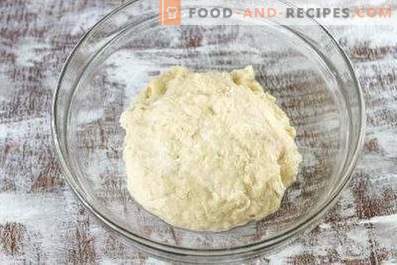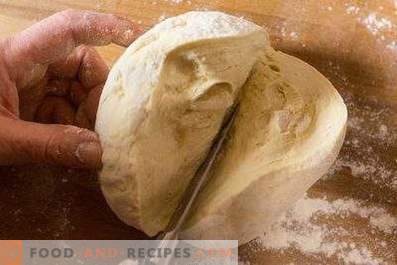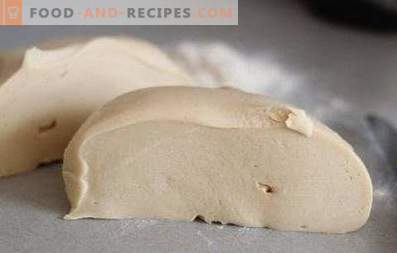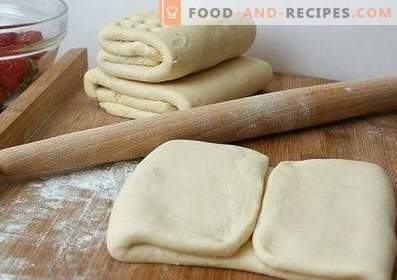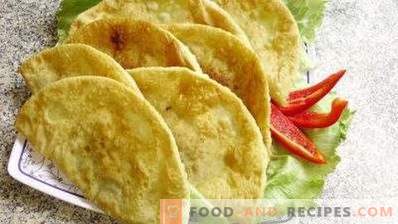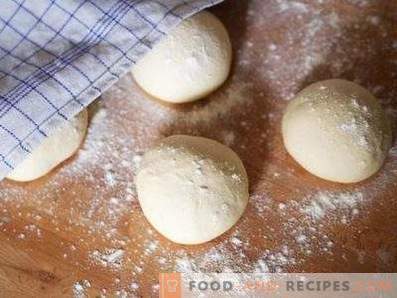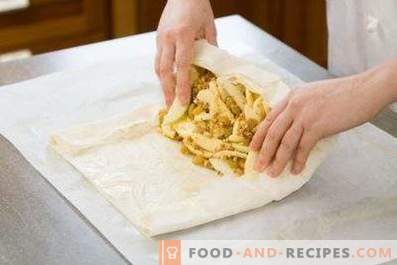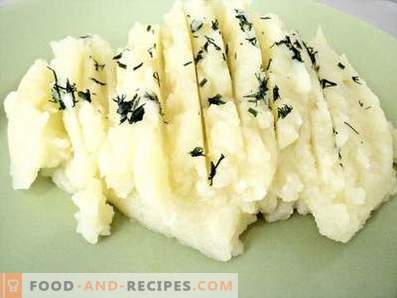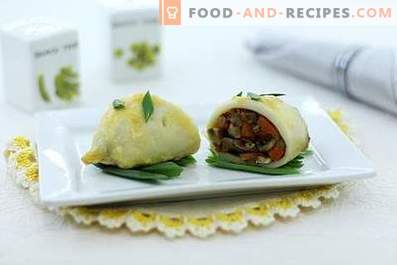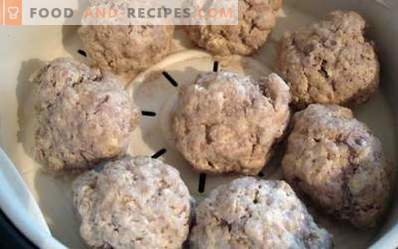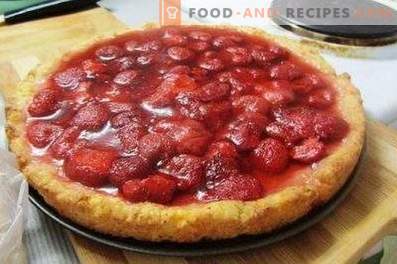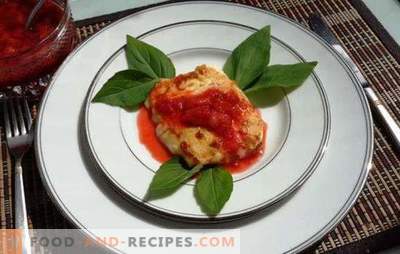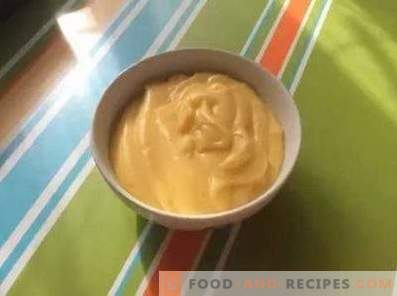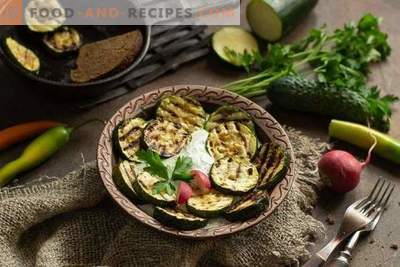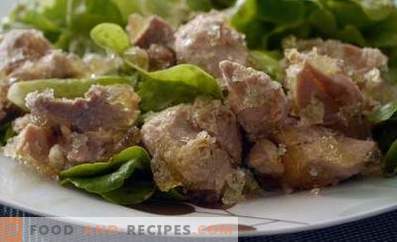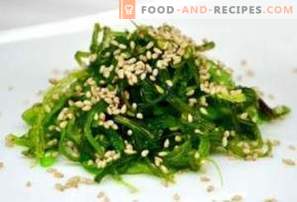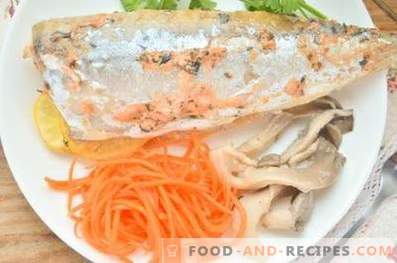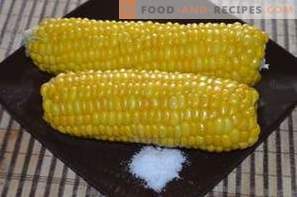
Whoever rested in Greece was almost certainly amazed by the unusual taste of local pastries. The flour shell in rolls and buns is thin here, often multi-layered, tender and crunchy. A person who is not familiar with the characteristics of Mediterranean cuisine, it may seem that this shell is made from the usual puff pastry, but extremely skillfully cooked. This is not true. The basis is a unique filo dough, which has nothing in common with puff pastry. Analogues of it exist in some other countries of the Mediterranean, where they are known by other names. Filo is the finest fume dough that is prepared without yeast and contains a simple and affordable set of products: water (less often milk or kefir), flour, salt, olive or other vegetable oil. It may contain eggs or only egg yolks, vinegar or lemon juice, starch, but these products are not mandatory.
Cooking Features
The secret of the filo dough is not only in its composition, which plays a big role, but also in the preparation technology. Knowing the subtleties of the selection and preparation of products, the nuances of kneading the dough itself, even a cook who does not have extensive experience will cope with the task.
- Filo dough flour is chosen with a lot of gluten. It makes the dough so elastic that it becomes possible to stretch it into a large layer with a thickness of not more than 1 mm. If you doubt the quality of the purchased flour, it makes sense to add to the dough a little gluten, bought separately. Otherwise, have to abandon the idea.
- Flour must be sieved before combining with other ingredients. Experienced chefs do this twice. The purpose of this manipulation is not only to get the product out of the flour moth and small industrial litter. The main task is to saturate the flour with oxygen. After sifting, it becomes much easier. This makes baking out of it more tender. Sifted flour combines better with other ingredients without the formation of lumps, which is especially important when making dough filo.
- To make the dough more elastic, add vegetable oil and lemon juice. The Greeks use olive oil, but it can be replaced with refined sunflower. Instead of lemon juice, you can add vinegar or do without this component. More durable and tasty dough make chicken eggs.
- After kneading, the filo dough is beaten off within 2-3 minutes, making about fifty blows to the table top (or a bowl, board). It is then left alone for at least half an hour, but usually for a longer time. This is necessary in order for the gluten contained in flour to be well swollen and make the dough more malleable.
- Filo dough is rolled out only at the very beginning, after it is pulled by hand. The rolled sheets are covered with a wet towel so that during the rolling of other layers it does not dry. After the thin layers of filo dough, they are sandwiched with parchment or starch, rolled into a roll and stored in a freezer for storage or immediately used for baking.
To make the filo dough look puffy in baking, several layers of it are laid on top of each other, oiling generously with butter, and used to form rolls or other products.
Classic recipe for filo dough without eggs
Composition:
- wheat flour - 0, 35 kg;
- water - 0, 2 l;
- olive oil - 50 ml;
- salt - 3 g;
- lemon juice - 20 ml.
Method of preparation:
- Boil water, add salt to it, stir it - the salt should dissolve. Cool the water to room temperature, pour into a bowl.
- Add olive oil and strained lemon juice to salted water. Whip them with a whisk to get a uniform liquid.
- Sift flour. Pour about 50 g for sprinkling dough when rolling it.
- Make a well in the remaining flour, pour the prepared liquid into it, stir it. When mixing the dough with a spoon becomes difficult, sprinkle flour on the working surface of the table and hands, put the dough on the table and complete the process of kneading it with your hands.
- Within 2 minutes, beat the dough by hitting it on the tabletop.
- Divide the dough into 3 parts, form koloboks from them, sprinkle them with flour, wrap with cling film. Leave on the table for 30-60 minutes.
- Take one piece of dough, put it on a floured countertop. Roll out as much as you can so that the dough is guaranteed not to tear.
- Wrap the dough around the rolling pin, as if forming a roll. Pressing the rolling pin on the table, expand the dough. Repeat until the dough is less than 3 mm thick.
- Sprinkle flour over your hands, pick up the dough. Spreading your hands from the center to the edges of the dough and rotating it along the axis, stretch into a transparent layer about 1 mm thick.
- Put a layer on the table, cover it with a wet towel, and take a second piece of dough. When it is ready, put parchment on the first layer, put a second on it, cover it with a towel.
- Also roll and stretch the third layer. Laying the parchment, put it on the first layers.
After this, the dough can be layered with butter and make a roll, baklava or other sweets out of it. Suitable dough for making savory rolls, envelopes. If you plan to use the dough later, roll it up and put it in the freezer. In the future it will be enough to defrost.
Filo dough with egg
Composition:
- wheat flour - 0, 4 kg (not counting the consumption for rolling);
- water - 0, 25 l;
- chicken egg - 1 pc .;
- olive oil - 50 ml;
- salt - 5 g.
Method of preparation:
- After boiling water, dissolve salt in it. Allow the water to cool to room temperature.
- In a clean bowl, break an egg. Shake his whisk.
- Add salt water and oil to the egg. Whisk liquid foods with a whisk.
- Sifting flour, make a recess in it. Pour the liquid mixture into it.
- Stir the food and knead the dough. Beat him at least 30 times.
- Divide the dough into 4 pieces, wrap them with cling film, put them in a cool place for half an hour (you can put them in the fridge).
- Put a linen towel on the table, sprinkle it with flour.
- Put the first piece of dough on the towel. Roll it out as far as possible.
- Stretch the dough with your hands until a towel is visible through it.
- Sprinkle flour on the dough, cover with parchment and a damp cloth.
- Similarly, roll out and stretch the remaining dough, stacking the layers on each other and sandwiching them with parchment. Do not forget to cover the pile with a damp cloth so that the dough does not dry out.
You can use the dough immediately after cooking or freeze to use it later.
Filo dough with egg yolks
Composition:
- wheat flour - 0, 45 kg;
- water - 0, 25 l;
- salt - 5 g;
- egg yolks - 3 pcs .;
- table vinegar (9 percent) - 5 ml;
- refined vegetable oil - 50 ml.
Method of preparation:
- Pour warm boiled water into a large bowl, add salt to it. Stir to dissolve the salt. If the crystals remain undissolved in the dough, it will be more difficult to roll it thin.
- Separate yolks from proteins. Protein store in the refrigerator, to later be used to prepare another dish. Send the yolks in a bowl of water, whisk.
- Pour the oil and vinegar into the bowl, whisk it all together.
- Sift flour. Pouring it to a liquid base with portions, knead the dough, smooth without floury lumps.
- Beat it on the board, place it in a plastic bag and leave it at room temperature for an hour.
After the specified time, the dough can be divided into 5-6 parts, roll out and stretch.
Filo pastry with starch
Composition:
- wheat flour - 0.5 kg;
- starch - 100 g;
- chicken egg - 1 pc .;
- refined vegetable oil - 50 ml;
- grape vinegar (6%) - 20 ml;
- salt - 5 g.
Method of preparation:
- Dissolve salt in warm boiled water, add egg, whisk.
- Pour in oil and vinegar to the liquid mass, whisk the liquid ingredients again.
- Make a hole in the sifted flour. Pour the liquid mixture into it. Stir the products with a spatula.
- Put the dough on a floured countertop, complete the kneading process with your hands.
- Beat the dough for 2-3 minutes, wrap it with cling film and put it in the fridge for half an hour.
- After half an hour, divide the dough into 3 parts.
- Flatten each part, turning it into a cake with a diameter of 5-7 cm.
- Sprinkle the tortillas with starch on all sides, put them in a pile.
- Roll the stack into a 2-3 mm thick layer, sprinkling dough in the process of rolling starch.
- Stretch the layer of dough with your hands so that it becomes transparent.
The dough can be used immediately or, by rolling a roll, freeze. Starch will not allow it to stick together, so you can do without the use of parchment.
Philo is an unusual thin dough made in Greece and some other Mediterranean countries. It is suitable for making rolls, pies, which are often made in the form of an envelope, baklava and other sweets. Fillets and envelopes of filo pastry can also be prepared with savory fillings. Due to the fact that the flour base is extremely thin and crispy, baking from it acquires a unique delicate flavor.



